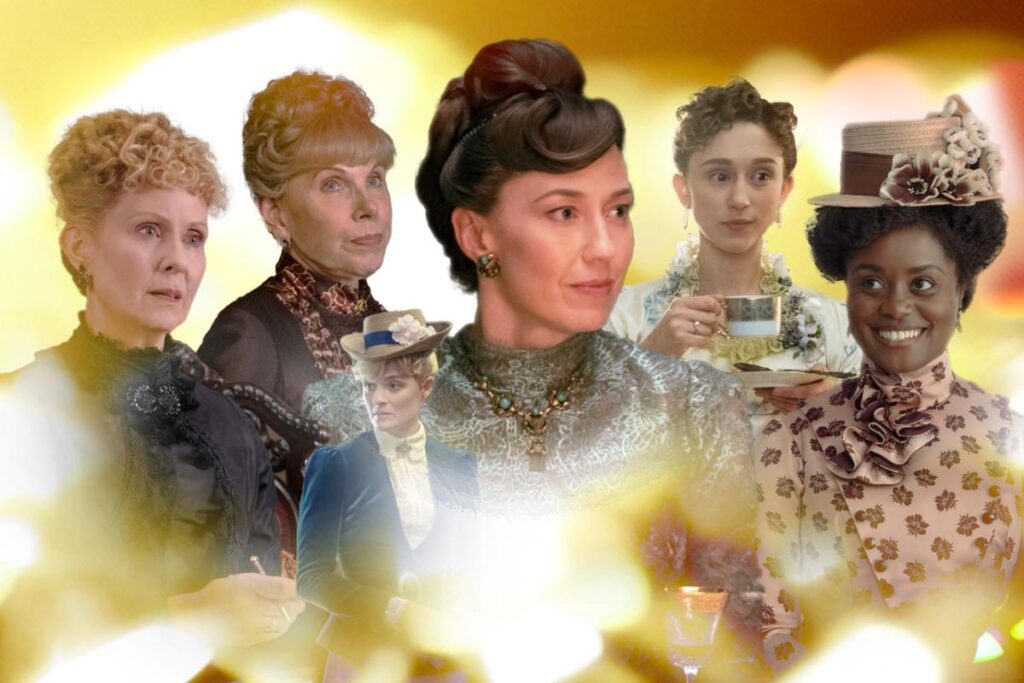It is a time of massive economic inequality, where the “haves” not only outstrip the “have nots” like never before, but demand more, more, and more. Corporate titans seek to expand their businesses by squashing any and all competition. Ferociously ambitious mothers push their children into the spotlight in pursuit of even more fame and fortune than they already have. The masses distract themselves from their own troubles by latching onto gossip about their betters’ sordid personal lives. This is 2025 and it’s also HBO‘s The Gilded Age.
The Gilded Age returns for its third season this month, taking us back to the world of late 19th century New York City, where the Russells, Van Rhijns, their friends, their frenemies, and, oh, yes, their servants interact and, crucially, compete. The Gilded Age Season 3 finally makes good on several juicy storylines that creator Julian Fellowes and co-showrunner Sonja Warfield have been seeding since the very first episode.
Years after their Season 1 meet cute, series sweethearts Marion Brook (Louisa Jacobson) and Larry Russell (Harry Richardson) get to embark on their fairy tale romance, covert kisses and all. Beloved footman Jack (Ben Ahlers) gets his long-awaited shot to sell his alarm clock. The brilliant Peggy Scott (Denée Benton) gets to be swept off her feet by a handsome (and blessedly single) Black doctor. Most importantly, though, The Gilded Age finally gives Gladys Russell (Taissa Farmiga) the full Consuelo Vanderbilt storyline, with some stunning twists.
The Gilded Age Season 3 is a must-watch for fans who have kept up with the Russells since the lavish soap opera’s debut in 2022. It’s a show that understands its subject matter on a meta level, reflecting the good and bad of the titular time period in tone and style.
The Gilded Age was originally pitched to NBC as a prequel series to Downton Abbey that would tell the story of how American heiress Cora Levinson (Elizabeth McGovern) married Lord Grantham (Hugh Bonneville). However, it eventually made its way to HBO as its own unique beast: a massively expensive drama following the petty problems of an insanely large cast of characters, mostly played by New York City theater greats.
The Gilded Age follows the rise of the Russell family. Robber baron patriarch George Russell (Morgan Spector) has built a financial empire with railroads and steel mills. His social-climbing wife Bertha (Carrie Coon) has made it her mission to further the family’s clout by conquering the insular world of Old New York aristocrats. Season 1 saw Bertha clawing into Lina Astor’s (Donna Murphy) inner circle, while Season 2 tracked her plot to build the Metropolitan Opera House as a home for old and new money families to mingle. Now, she has her sights set on marrying her shy daughter Gladys to the Duke of Buckingham (Ben Lamb).
In past seasons, Bertha was working at odds with the snooty women who ruled over New York society. Now, her ambitions put her at odds with her own family. George has already promised Gladys that she can marry for love and the young heiress just so happens to be sweet on the respectable, but not royal, Billy Carlton (Matt Walker). When Bertha faced down the Lina Astors of New York City, she had her equally implacable husband in her corner. What will happen when these two unstoppable forces collide when it comes to the future of their children?
Across the street, the Van Rhijn household is in tumult following the abrupt changes in fortune for sisters Agnes (Christine Baranski) and Ada (Cynthia Nixon) last season. Agnes’s son Oscar (Blake Ritson) was swindled out of the family fortune by con artists just in time for newly widowed Ada to discover her priest husband secretly came from money. Ada is technically in charge now, creating friction between the sisters and chaos amongst the staff.
Mark Twain famously coined the phrase “Gilded Age” in response to contemporaries insisting they were living in a “Golden Age.” Twain knew better. High society’s decadence only masked the rot of political corruption and glut of abject poverty that defined the era. I’ve always felt that HBO’s Gilded Age is a great representation of this time period precisely because most of its joys are superficial. This isn’t a deep drama, but a frothy soap opera produced by the industry’s best actors, artists, and artisans.
Gilded Age devotees already know that we’re absolutely spoiled by the glut of acting talent in this show, but there are nevertheless few standout performances this season. Carrie Coon is once again outstanding as the cravenly conniving Bertha Russell in a season that forces the indomitable character to soften like never before. (The fact that Coon is following up her sensational turn on The White Lotus with her best Gilded Age work is kind of insane?) Taissa Farmiga gets take center stage as Gladys, revealing layers to a character hitherto stuck in her mother’s shadow. Denée Benton manages to portray Peggy with both strength and vulnerability, as she pursues a potential happily ever after. Finally, The Gilded Age Season 3 finally takes advantage of having Broadway greats Kelli O’Hara and Audra McDonald in the cast, giving their characters juicier material than ever before.
The Gilded Age is a show that understands what drives interest in the Gilded Age to this very day. It was a time of insane opulence, captivating scandals, and shallow pursuits. The Gilded Age reflects this to a tee with its sumptuous sets, exquisite costumes, and brilliant performances. It’s an upscale version of the classic primetime soap and one that’s perfect to get lost in when real life drama is too much.
The Gilded Age Season 3 premieres on HBO on Sunday, June 22 at 9 PM ET.
Read the full article here








